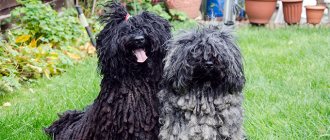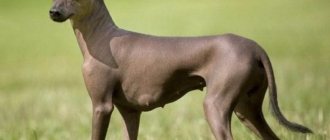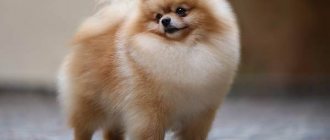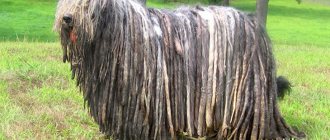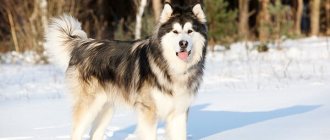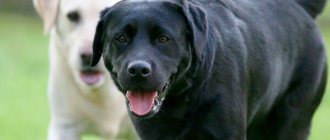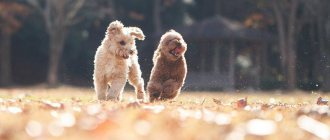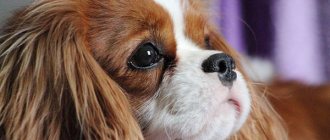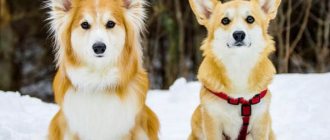- October 18, 2018
- Dogs and hunting with them
- Kira Ifeevskaya
There are a huge number of different dog breeds in the world. Each of them has only its own properties and can perform certain functions. The northern husky, photos of which show all the power and grace of the animal, is today in great demand as a pet. This is one of the oldest breeds that faithfully serves people. To find out what types of likes there are, you need to figure out for what purposes people can use them. Based on many characteristic features, one can judge that they were once closely related to wolves and jackals.
Different types of huskies in different parts of the world were used by people to serve in the areas and spheres inherent in these places. The centuries-old use of these dogs to perform certain jobs has divided them into several groups: herding, sledding and hunting breeds. Let's look at the varieties of huskies that correspond to these groups.
Shepherd huskies
Representatives of this group trace their ancestry back to Nenets Laikas. These are small, light and compact dogs. The height at the withers is about 45 cm for males and 40 cm for females. To protect them from the harsh northern climate, they are given long, warm wool. The skull is wide, the forehead is moderately convex with a clear transition to the muzzle. The muzzle itself is shorter than the skull, the cheekbones are dry, tightly covered with skin. This subgroup is most optimal for shepherd service and is an excellent assistant to shepherds. Despite the fact that the husky is small, it has proven itself excellent in hunting waterfowl, wild birds, squirrels and, surprisingly, bears.
These dogs have a square body, triangular ears, strong paws and brown eyes. This type of husky is endowed with a short fluffy tail, curled into a half ring. The muzzle of such dogs is decorated with whiskers, the chest and neck visually represent a collar with a frill. The front and hind legs have breeches and feathers. The long and dense coat on the lower part of the paws makes them larger, which allows this type of husky to easily move across endless snowy expanses without falling into the snow. A coat of eight centimeters protects dogs from high frosts down to minus fifty degrees, and from forty-degree heat, as well as from annoying gnats and midges. Due to such a thickness of wool, they are not even in danger of being burned when they come into contact with a hot stove.
Shepherd huskies have different colors: black, gray. You can also find representatives of the breed that are brown with splashes of white. This type of huskies has an amazing sense of smell, which allows them to warn shepherds in advance of approaching danger. These dogs are gentle, have a lively and active character, are very sociable, but they show distrust of strangers. Very self-possessed and psychologically stable. They cope well with herding functions and have good hunting skills. Their characteristic qualities include courage, resourcefulness, and balance.
With blue eyes
If you thought that blue eyes are a distinctive feature of the Husky, then you were wrong. There is also a variety of Laikas, whose eyes can also be a rich heavenly shade. We are talking about the Yakut representatives of the group.
They were very valuable animals in Yakutia, not only because they were endowed with all the abilities and characteristics of the breed group, but also because mystical properties were prescribed to them. It was believed that such a dog brings happiness and prosperity to the house and acts as a kind of guardian angel. This was not far from the truth, since pets could really sense the approach of any danger and warn their owners about it.
The FCI recognized the breed only conditionally, but approved the current standards. Monochromatic color is allowed only white; it is mainly a spotted animal, often combining black and white colors on its skin in a beautifully painted pattern.
Riding huskies
Dogs that perform draft functions belong to the group of sled huskies. Their height at the withers is about sixty centimeters. This is the largest subgroup, extremely necessary in the north, where there are no roads, and they have to cover huge distances only by dog sleds. This special type of husky has undergone a harsh selection by nature and has developed its outstanding qualities thanks to long-term living in very difficult conditions. As a result of centuries of selection, the coat of such dogs has become dense and hard, with a soft, thick undercoat that prevents the dog from freezing even in the most severe frosts.
Sledable huskies have a stretched body and long paws, which allows them to move freely in deep snow. They are very unpretentious and can easily tolerate periodic and monotonous meals. Their ancestors are considered to be the North Kamchatka dogs and the wild wolf. These dogs are perfectly adapted to local conditions and are capable of transporting not only people, but also large loads over long distances in any weather conditions. As a rule, all types of huskies in this group can make decisions independently in the most extreme situations. There is a lot of evidence of how dogs returned for a musher who had fallen from the sled, dug out people and cargo in snow avalanches, and found the right path during a snowstorm.
What breeds are sled dogs?
The group of sled huskies includes a variety of breeds. In Chukotka alone they use three types. The Eskimo, Greenland and Kamchatka sled dogs have some differences. Kamchatka specimens are slightly larger; they do not have a pronounced characteristic mask. There are visible light circles under the eyes, making them look like Alaskan Malamutes. In this group, representatives of all breeds of huskies are strong and muscular, which allows them to successfully pull the strap not only in deep snow, but also on strong crust or ice.
The group of sled dogs includes:
- American Indian dog;
- West Siberian Laika;
- Norbotten Spitz;
- Shiba Inu.
All these varieties of sled dog breeds are very strong and hardy, with strong and powerful bones and a very developed chest.
Price
On average, the price of a husky puppy costs from twenty thousand rubles. It is important to decide for what purpose you are purchasing a pet.
If as a friend and security guard, then official recognition and permission to participate in exhibitions will not be important for you. If you only want a world-famous and officially recognized breed, then the list of candidates for the role of your pet is narrowing.
You can purchase any of the listed varieties of the group in Russia.
Hunting huskies. Description
Hunting huskies are the most numerous of all hunting dog breeds. This breed is considered universal for hunting and dates back to the times of ancient people, when only the dog was tamed and began to help man hunt other animals. They have a well-developed hunting instinct, excellent sense of smell, excellent hearing and acute vision. They have a quick reaction and can be used for hunting fur-bearing animals - sable, marten, squirrel, mink, ermine. In addition, the hunting husky (its photo is presented in the article) has proven itself excellent in hunting birds and large game - wild boar, elk, bear. Its task is to find the game and bark at it in order to indicate to the hunter its location, as well as to divert attention to itself.
These are nimble, active dogs, they need to work and expend energy. With a lack of physical activity, huskies become sad, which is why they can begin to misbehave: damaging furniture and shoes, making noise, howling.
Let's look at some types of hunting huskies, the most popular and frequently encountered.
Mating
Puberty, along with the first estrus, occurs in West Siberian husky bitches before one year. But this is a very early age for mating. You should not breed a dog of any gender before 18 months of age.
For good and healthy offspring, it is necessary to carefully choose the cable for mating (it is advisable that the partner has documents).
Before estrus, the female usually begins to behave restlessly, or, on the contrary, she will be too calm. Also, the pet will often ask to go outside. Another two signs of imminent estrus are enlarged genitals and spotting. But before mating, you need to wait until clear discharge appears.
- First, the dogs need to have a first date, which will take about 15 minutes . The best time is morning. Pets should not be fed before mating. The entire process must be under the control of both owners.
- Sexual intercourse of huskies can last up to 45 minutes. But the next morning you will need to repeat the procedure.
- It happens that the bitch does not allow the cable to come near her. This means that she needs more time to get to know each other. And it happens that she simply doesn’t like her partner. And then you won’t be able to breed dogs.
- If the husky mating was successful, then after about three weeks you will notice a rounded tummy on the pet. The pregnancy itself can last up to 2.5 months . And in the first month there should be no changes in the dog’s life. After all, pregnancy is not a disease. When you enter the second month of pregnancy, you can increase your diet to three meals.
- It is better to arrange an enclosure in one of the rooms, and place the expectant mother there about a week before the birth. The main thing is that the room is warm and dry. It is necessary to place a box with a diaper in the room. And during pushing, make sure that the pet is in the bed. Because during the first birth, the dog may get scared and start looking for a hiding place.
After the first puppy appears, you cannot touch the bitch. After giving birth, it is necessary to wipe the pet's genitals. After feeding the puppies, she can be taken outside for a short time for natural reasons.
Russian-European. Description of representatives
The Russian-European Laika is a dog of medium height (52-58 cm), strong build and lean constitution, agile and lively, with well-developed muscles. She has a wedge-shaped head with a wide skull, the muzzle is shorter than the length of the skull, the transition from the forehead to the muzzle is hardly noticeable, the cheekbones are clearly defined. The eyes are cheerful, oval, with a slight slant, and the ears are triangular and erect. The legs are straight and level, the tail is curled and pressed to the back or thigh. The coat is coarse and thick, long and straight, with a dense soft undercoat. There is a lush collar of wool and scruff on the neck, shoulders and withers. On the hind legs the hair is longer and shaped like pants. Colors include black, piebald, white, red and zonular.
The dog has a very friendly character, is very independent and balanced, it is characterized by agility and playfulness, devotion and loyalty to the owner. It should be washed and bathed only when necessary, since dogs are very clean and tidy.
West Siberian Laika. Description of the appearance of the breed representatives
The West Siberian Laika is similar in height and constitution to the Russian-European Laika. Its height is 54-60 cm. The head has a wedge-shaped structure, the length of the muzzle is almost the same as the width of the skull, and the occipital protuberance is strongly pronounced. The transition from forehead to muzzle is smooth. The ears are elongated triangular, the eyes have an oblique cut. The neck is lean and muscular, the chest is wide and the withers are developed. The belly is tucked in, the tail is crocheted, the paws are straight. Thick hair on the neck, shoulders and withers forms sideburns and a collar. Color black, white, brown, red, zoned. Representatives of this breed are very smart and intelligent, have excellent contact with the owner, but are distinguished by their touchiness.
Karelo-Finnish. Description of the breed
Many people do not know the name of the red husky breed. This breed is called Karelian-Finnish because this husky was bred by crossing Karelian and Olonets hunting dogs with Finnish Spitz. This is a very friendly and cheerful dog, bright red and with its muzzle similar to a bear cub. The Karelian-Finnish husky is small in size - only 42-48 cm at the withers, but strong and incredibly agile. Her head is wedge-shaped, the transition from forehead to muzzle is almost imperceptible.
The muzzle is pointed, the ears are oval, small and erect, the eyes are slanted. The withers are well developed, the back is straight and muscular. The paws are straight, the tail is a ring. The coat is straight, hard and very dense with a lush soft undercoat. There are feathers on the hind legs. On the shoulders and neck, the long coat forms a lush, rich collar and stylish sideburns. These cute red huskies (photos of them are presented in the article) have a kind, playful disposition, are very peaceful and friendly, have excellent contact with children, but do not tolerate loneliness well.
Despite her rather modest dimensions, this red-haired beauty has a proud character and is not particularly obedient. Training her will take a long time and painstakingly. But her easy-going nature and cheerful character compensate for these difficulties and make the training process fun for both the dog and its owner. She is very cheerful and charismatic, but at the same time willful. She loves independence and autonomy, is extremely suspicious of strangers and adores her own. She also has an amazing memory.
Advantages and disadvantages
Pros:
- quickly adapt to harsh climates;
- unpretentious in food and maintenance;
- friendly and cheerful disposition;
- good health;
- nice exterior;
- people-oriented;
- attachment to family;
- easily find a common language with young children;
- universal hunters.
Minuses:
- shed heavily;
- cannot tolerate heat and apartment living;
- increased level of activity;
- They can be capricious and take offense at injustice.
Caring for the Karelian-Finnish Laika
When you decide to adopt a Karelian-Finnish Laika into your family, you must understand what kind of care she needs. Her restlessness requires a mandatory long walk. Long hair requires grooming to prevent tangling. This husky sheds twice a year, but apart from combing out the old fur, it does not require any other care. It does not have a sharp specific odor, so it is washed only once or twice a year. She needs her own place, and food should not be near her rookery.
Nutrition
Determine immediately:
Dry food is convenient for trips or long trips with your husky.
Homemade food is healthier for such a dog. For good health, a balanced diet is essential.
Feed puppies 5 times a day, when they turn 0.5 years old - 4 times, and adults - 3 times a day.
Advice! Mixing dry food with homemade food is strictly prohibited!
Be sure to have a clean bowl of water, change the water 2 times a day!
Your pet needs to cook food! Cook porridge with meat broth. The dog must eat a portion; if it does not finish, reduce the amount of food.
After any walk (run), feed after 30 minutes.
Puppies can eat meat only when they are 1 year old. Only periodically can you give raw tripe for vitamins.
The diet includes: beef (no other meat), poultry, cleaned sea fish (no river fish!), dairy products (eggs, cottage cheese, kefir), nutritious porridges (buckwheat, rice, etc.), various vegetables and herbs.
You can give 1 fruit a day, monitor the reaction to avoid allergies.
Important! Do not give: spices, chocolate, soda, potatoes, smoked meats.
Choose the most inquisitive and nimble puppies, this is an indicator of excellent health. If you feed properly and lead an active life, you will gain a best friend, helper and protector.
We offer a photo gallery of all types of huskies.
Siberian Laika
The Siberian Laika (pictured below) is a northern beauty. This is a very intelligent hunting dog with well-developed intuition and an exceptional sense of smell. Representatives of the breed are very dexterous and friendly, loyal and faithful. This is one of the breeds that has retained its essence almost in its original form. These dogs are closest to nature and the ancestors from which they originated.
The Siberian is the largest breed of Laika. She was bred in harsh natural conditions. Siberian huskies are divided into two types - East Siberian and West Siberian. The second type has already been mentioned above; now the East Siberian breed should be highlighted.
Compared to its West Siberian relative, the East Siberian Laika has a more elongated format and larger sizes. Its height at the withers averages 55-65 cm, sometimes reaching seventy centimeters. In addition, she has a stronger bone structure and a stronger body. The head is wedge-shaped with a wide skull and a rounded nape. The length of the muzzle and skull are almost the same. The transition to the muzzle is smooth and imperceptible. The ears are triangular, erect, very mobile. The eyes are oval with a moderately oblique slant. Muscular neck and well-developed withers, powerful straight back. The paws of such a dog are straight and muscular. The tail of representatives of the breed is curved in a ring. Very fast and light dogs, easily moving from gait to trot and gallop.
Despite their large size and strong body, these huskies are very active and mobile. Their weight is about 20-25 kg. These powerful animals have a very quiet and calm character. They are not at all aggressive, they are well versed in the terrain, very dexterous, maneuverable and incredibly brave. Thanks to their distinctive qualities, they have proven themselves excellent in hunting. They love to play with a ball or a stick and do not show aggression towards humans.
The dog can serve as a sled dog, pulling children in sleds. She is attentive and fearless - if her owner is in danger, she will do everything to protect him. They have an excellent natural instinct, which helps them to always be on guard and cope well with their security duties.
Siberian Laika. Where is the best place to keep and how to care for such a dog?
The East Siberian Laika feels best in a spacious enclosure, but adapts well to life in an apartment. It’s just that the owners should always remember about the incredible activity of the pet and give it the opportunity to frolic for a long time in the open air - run, bark. Thick and long hair will be subject to periodic shedding. Therefore, you will have to comb the dog thoroughly and be prepared for the fact that during this period, pieces of fur will be scattered throughout the house.
Anyone who prefers silence will not be able to be close to a loud and restless husky. It is better if her owner is a hunting enthusiast, then she will periodically show her skills. If you don't like long walks and jogging, don't adopt this breed - it will be a burden for you and a pain for the animal. The East Siberian Laika is very prudent in its diet - it often eats in reserve, which is a very useful property for a hunting dog, which can be on the hunt for several days and does not require feeding.
Samoyed husky. Description of representatives of this species and their character
The Samoyed is also a fairly large dog, covered with thick white hair. It is able to withstand the incredible frosts inherent in the Arctic winter, with strong cold winds. The average height at the withers is fifty to sixty centimeters. Dogs may deviate slightly from the white color and take on a cream color.
The peculiarity of the Samoyed is its smiling mouth. This dog can also be used as a sled dog. Samoyeds are very friendly and affectionate animals. These dogs have a sociable disposition and are committed to family relationships. They get along well with children of different ages. You can keep a dog of this breed in an apartment. But you should provide her with sufficient stress so that she can use up excess energy. They do not tolerate loneliness well, do not like separation, and miss their owners very much when they have to part.
Owner reviews
A few reviews:
- “In my opinion, Laiki is the best dog on earth. I really like the fur colors of the Yakuts, especially when combined with a blue iris. But I have both a husky and a Samoyed. They combine everything a person needs from a four-legged friend.”
- “When I saw a glossy Elekkhund at an exhibition, I simply fell in love with this breed. But their fur tends to fade in the hot sun. This should be taken into account and measures taken in advance to preserve beauty.”
How to care for a Samoyed? Peculiarities
Although this breed is very woolly, it is not that difficult to care for. First of all, you need to comb the Samoyed correctly, separating the fur with one hand against the growth of the hair, and with the other, combing the fur in the direction of growth. Do not allow the fur to become tangled, as Samoyeds cannot be cut. When brushing is finished, run the comb against the grain of the hair to lift the undercoat. The dog sheds once or twice a year, and dry shampoo should be used for bathing. Daily walks with intense physical activity are required. Otherwise, such a dog will get bored and may even start acting out (gnawing something or howling).
Key points in training
It is necessary to train a puppy as soon as it is brought to its new home, because this breed is quite stubborn. We must immediately show who is in charge.
Training usually begins at about 10 months. Training begins with basic commands. Laikas are highly trainable. This is due to the habit of unquestioning obedience to the owner .
If the dog's owner is a hunter, then training is best carried out at special sites. Here the pet can get used to the light from the car headlights, the sound of gunshots and learn a lot of things that are necessary during the hunt.
Read about how to properly train a dog in the article: “Training a puppy: effective methods from dog handlers, learning commands at home.”
